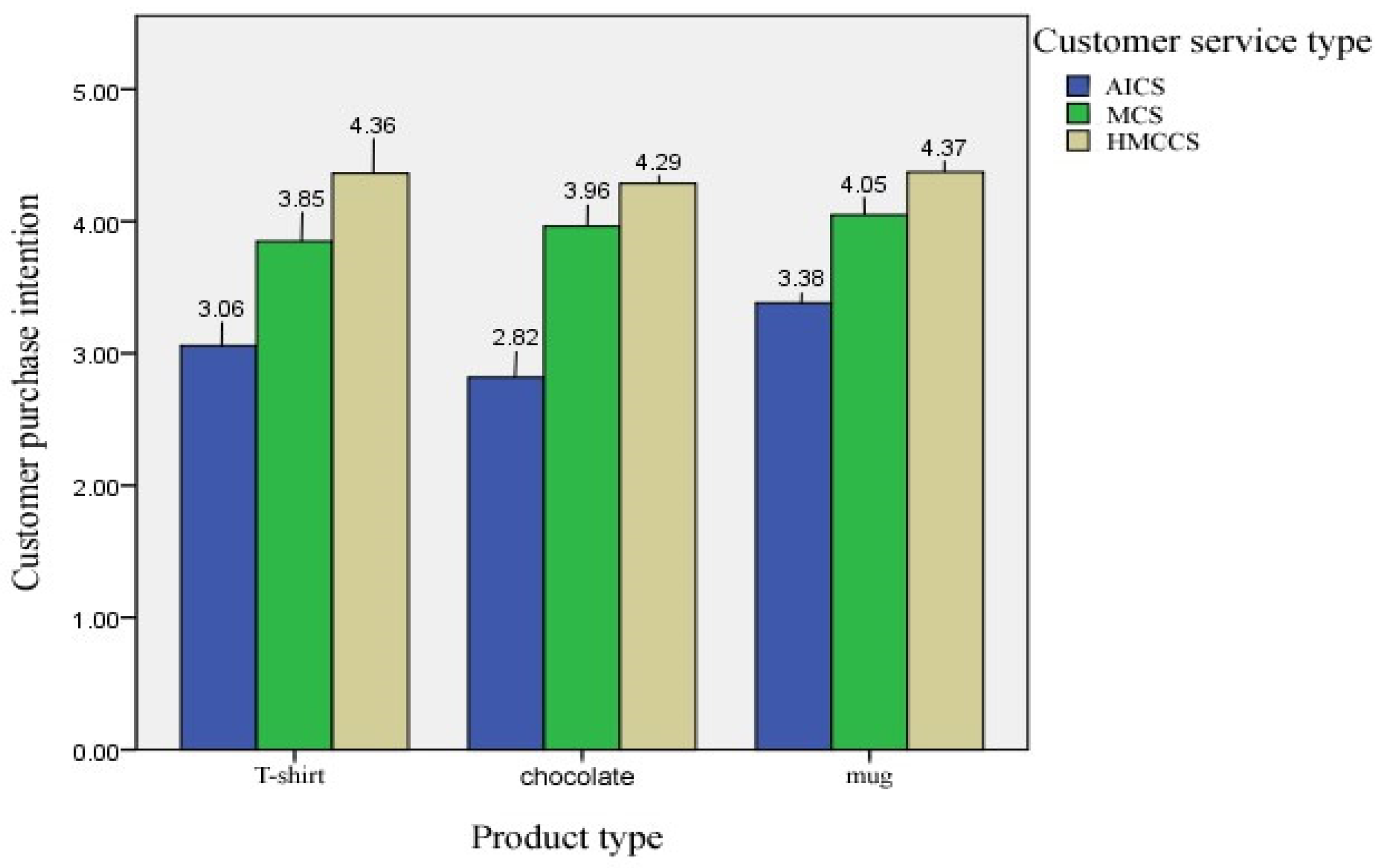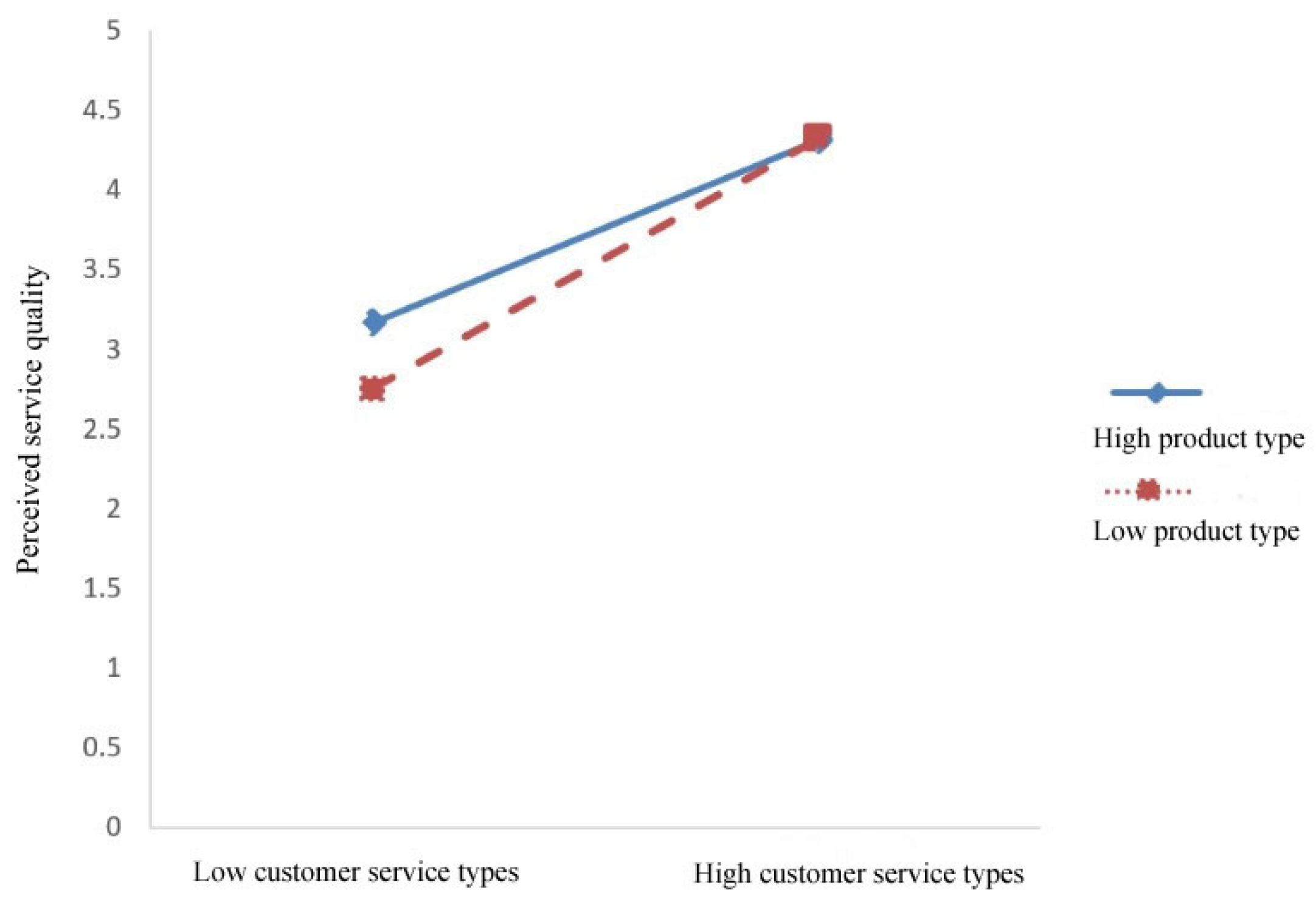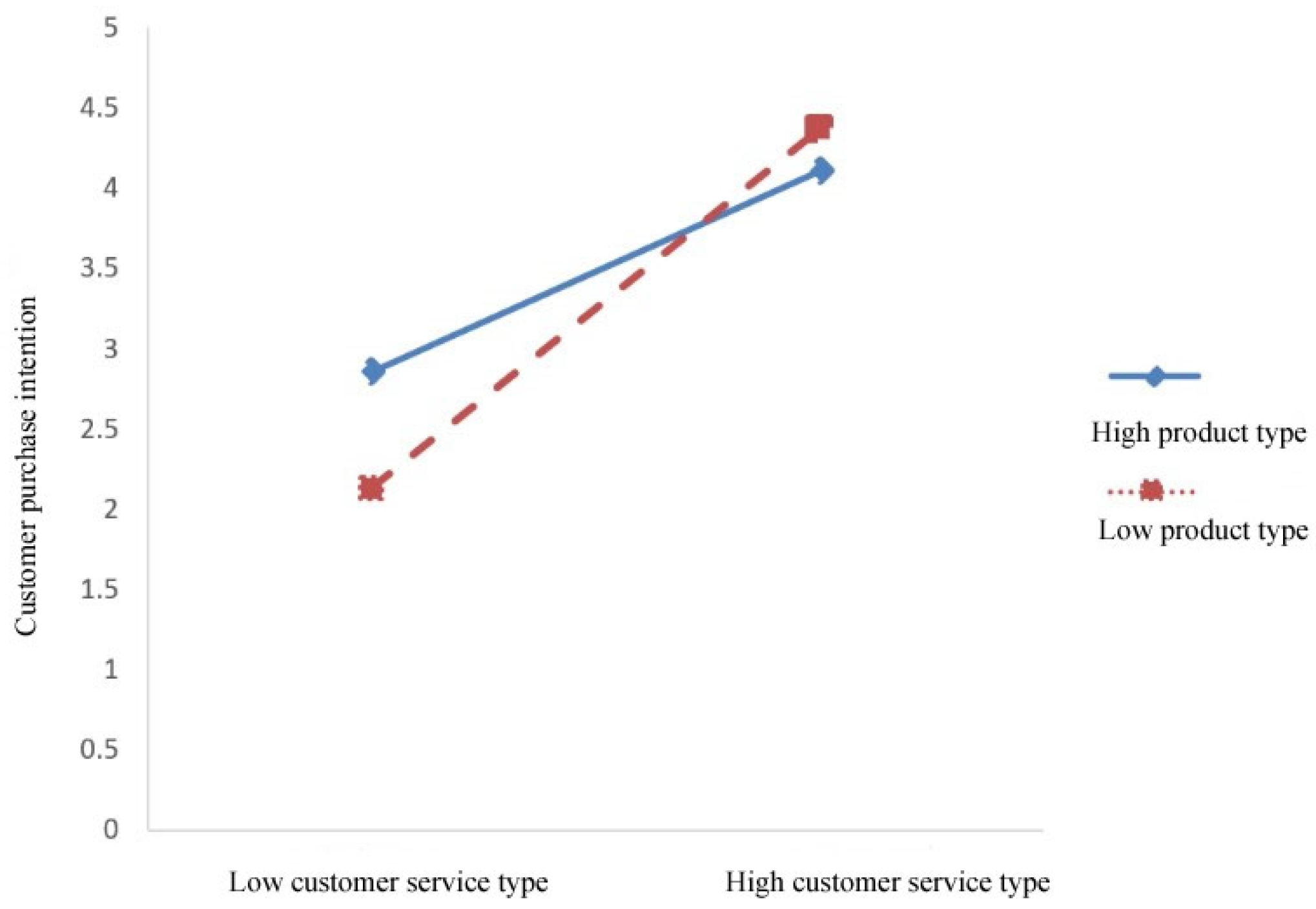Is Artificial Intelligence Better than Manpower? The Effects of Different Types of Online Customer Services on Customer Purchase Intentions
Abstract
:1. Introduction
2. Literature Review
2.1. Types of Online Customer Service
2.2. Perceived Service Quality
2.3. Service Encounter Theory
2.4. Superposition Theory
3. Research Hypothesis and Research Model
4. Research Method
4.1. Laboratory Experiment 1
4.1.1. Experimental Design
4.1.2. Analysis and Results
4.2. Laboratory Experiment 2
4.2.1. Experimental Design
4.2.2. Analysis and Results
5. Discussion and Implications
5.1. Conclusions
5.2. Theoretical Contributions
5.3. Managerial Implications
5.4. Limitations and Future Research
Author Contributions
Funding
Institutional Review Board Statement
Informed Consent Statement
Data Availability Statement
Conflicts of Interest
References
- Carsten, H. IFR Presents World Robotics Report 2020. 2021. Available online: https://ifr.org/ifr-press-releases/news/record-2.7-million-robots-work-in-factories-around-the-globe (accessed on 8 September 2021).
- Liu, S.H. Revenues from the Artificial Intelligence (AI) Software Market Worldwide from 2018 to 2025. 2021. Available online: https://www.statista.com/statistics/607716/worldwide-artificial-intelligence-market-revenues/ (accessed on 10 September 2021).
- Adam, M.; Wessel, M.; Benlian, A. AI-based chatbots in customer service and their effects on user compliance. Electron Mark. 2021, 31, 427–445. [Google Scholar] [CrossRef] [Green Version]
- Prentice, C.; Dominique Lopes, S.; Wang, X. Emotional intelligence or artificial intelligence–an employee perspective. J. Hosp. Mark. Manag. 2020, 29, 377–403. [Google Scholar] [CrossRef] [Green Version]
- Chung, K.; Park, R.C. Chatbot-based heath care service with a knowledge base for cloud computing. Clust. Comput. 2019, 22, 1925–1937. [Google Scholar] [CrossRef]
- Xiao, L.; Kumar, V. Robotics for customer service: A useful complement or an ultimate substitute? J. Serv. Res. 2021, 24, 9–29. [Google Scholar] [CrossRef]
- Song, M.; Xing, X.; Duan, Y.; Cohen, J.; Mou, J. Will artificial intelligence replace human customer service? The impact of communication quality and privacy risks on adoption intention. J. Retail. Consum. Serv. 2022, 66, 102900. [Google Scholar] [CrossRef]
- Mosa, R.A. The Influence of E-Customer Relationship Management on Customer Experience in E-Banking Service. Soc. Sci. 2022, 12, 193–215. [Google Scholar] [CrossRef]
- Davenport, T.; Guha, A.; Grewal, D.; Bressgott, T. How artificial intelligence will change the future of marketing. J. Acad. Mark. Sci. 2020, 48, 24–42. [Google Scholar] [CrossRef] [Green Version]
- Gray, K. AI can be a troublesome teammate. Harv. Bus. Rev. 2017, 2, 20–21. [Google Scholar]
- Klumpp, M. Automation and artificial intelligence in business logistics systems: Human reactions and collaboration requirements. Int. J. Logist. Res. Appl. 2018, 21, 224–242. [Google Scholar] [CrossRef]
- Jin, S.V.; Youn, S. Why do consumers with social phobia prefer anthropomorphic customer service chatbots? Evolutionary explanations of the moderating roles of social phobia. Telemat. Inform. 2021, 62, 101644. [Google Scholar] [CrossRef]
- Luo, X.; Tong, S.; Fang, Z.; Qu, Z. Frontiers: Machines vs. humans: The impact of artificial intelligence chatbot disclosure on customer purchases. Mark. Sci. 2019, 38, 937–947. [Google Scholar] [CrossRef]
- Verhagen, T.; Van Dolen, W. The influence of online store beliefs on consumer online impulse buying: A model and empirical application. Inf. Manag. 2011, 48, 320–327. [Google Scholar] [CrossRef]
- Claro, D.P.; Ramos, C. Sales intrafirm networks and the performance impact of sales cross-functional collaboration with marketing and customer service. J. Pers. Sell. Sales Manag. 2018, 38, 172–190. [Google Scholar] [CrossRef]
- Thomas, D.R.E. Strategy is Different of Service Businesses. Harv. Bus. Rev. 1981, 53, 158–165. [Google Scholar]
- Yang, M.; Mahmood, M.; Zhou, X.; Shafaq, S.; Zahid, L. Design and implementation of cloud platform for intelligent logistics in the trend of intellectualization. China Commun. 2017, 14, 180–191. [Google Scholar] [CrossRef]
- Li, J. Analysis of the change of customer service of securities sales department under the background of “intelligence+”. Financ. Econ. 2019, 10, 175–179. [Google Scholar]
- Chen, G.; Qiu, H. Building intelligent customer service to help improve service. China Telecom Ind. 2019, 10, 52–53. [Google Scholar]
- Shawar, B.A.; Atwell, E.S. Using corpora in machine-learning chatbot systems. Int. J. Corpus Linguist. 2005, 10, 489–516. [Google Scholar] [CrossRef]
- Araujo, T. Living up to the chatbot hype: The influence of anthropomorphic design cues and communicative agency framing on conversational agent and company perceptions. Comput. Hum. Behav. 2018, 85, 183–189. [Google Scholar] [CrossRef]
- Chung, M.; Ko, E.; Joung, H.; Kim, S.J. Chatbot e-service and customer satisfaction regarding luxury brands. J. Bus. Res. 2020, 117, 587–595. [Google Scholar] [CrossRef]
- Cheung, M.L.; Leung, W.K.; Aw, E.C.X.; Koay, K.Y. “I follow what you post!”: The role of social media influencers’ content characteristics in consumers’ online brand-related activities (COBRAs). J. Retail. Consum. Serv. 2022, 66, 102940. [Google Scholar] [CrossRef]
- Vrontis, D.; Makrides, A.; Christofi, M.; Thrassou, A. Social media influencer marketing: A systematic review, integrative framework and future research agenda. Int. J. Consum. Stud. 2021, 45, 617–644. [Google Scholar] [CrossRef]
- Radziwill, N.M.; Benton, M.C. Evaluating quality of chatbots and intelligent conversational agents. Softw. Qual. Prof. 2017, 19, 25–35. [Google Scholar]
- Feine, J.; Gnewuch, U.; Morana, S.; Maedche, A. A taxonomy of social cues for conversational agents. Int. J. Hum.-Comput. Stud. 2019, 132, 138–161. [Google Scholar] [CrossRef]
- Nguyen, T. Potential Effects of Chatbot Technology on Customer Support: A Case Study. 2019. Available online: https://aaltodoc.aalto.fi/handle/123456789/38921 (accessed on 1 January 2022).
- Wang, L.; Gao, R.; Váncza, J.; Krüger, J.; Wang, X.V.; Makris, S.; Chryssolouris, G. Symbiotic human-robot collaborative assembly. CIRP Ann. 2019, 68, 701–726. [Google Scholar] [CrossRef] [Green Version]
- Epstein, S.L. Wanted: Collaborative intelligence. Artif. Intell. 2015, 221, 36–45. [Google Scholar] [CrossRef]
- McCaffrey, T. Human-AI Synergy in Creativity and Innovation. In Artificial Intelligence: Emerging Trends and Applications; IntechOpen: London, UK, 2018; p. 143. [Google Scholar]
- Ansari, F.; Erol, S.; Sihn, W. Rethinking human-machine learning in industry 4.0: How does the paradigm shift treat the role of human learning? Procedia Manuf. 2018, 23, 117–122. [Google Scholar] [CrossRef]
- Miner, A.S.; Shah, N.; Bullock, K.D.; Arnow, B.A.; Bailenson, J.; Hancock, J. Key considerations for incorporating conversational AI in psychotherapy. Front. Psychiatry 2019, 10, 746. [Google Scholar] [CrossRef] [Green Version]
- Malik, A.A.; Bilberg, A. Complexity-based task allocation in human-robot collaborative assembly. Ind. Robot. Int. J. Robot. Res. Appl. 2019, 46, 471–480. [Google Scholar] [CrossRef]
- Gronroos, C. Strategic Management and Marketing in the Service Sector Research; Swedish School of Economics and Business Administration: Helsingfors, Finland, 1988; pp. 83–104. [Google Scholar]
- Parasuraman, A.; Zeithaml, V.A.; Berry, L.L. A conceptual model of service quality and its implications for future research. J. Mark. 1985, 49, 41–50. [Google Scholar] [CrossRef]
- Gupta, D.K.; Khincha, P.K. Factors influencing online Shopping behavior of customers: An Empirical Study. Common Wealth J. Commer. Manag. Res. 2015, 2, 39–50. [Google Scholar]
- Dash, S.; Saji, K.B. The role of consumer self-efficacy and website social-presence in customers’ adoption of B2C online shopping: An empirical study in the Indian context. J. Int. Consum. Mark. 2008, 20, 33–48. [Google Scholar] [CrossRef]
- Shostack, G.L. Planning the Service Encounter. In The Service Encounter; Czepiel, J.A., Solomon, M.R., Surprenant, C.F., Eds.; Lexington Books: Lexington, MA, USA, 1985; pp. 243–254. [Google Scholar]
- Prus, R. The Dynamics of Service: Reflections on the Changing Nature of Customer/Provider Interactions. Contemp. Sociol. 1997, 26, 227. [Google Scholar] [CrossRef]
- Fan, X. Service quality management: Interaction process and interaction quality. Nankai Manag. Rev. 1999, 1, 8–12. [Google Scholar]
- Solomon, M.R.; Surprenant, C.; Czepiel, J.A.; Gutman, E.G. A role theory perspective on dyadic interactions: The service encounter. J. Mark. 1985, 49, 99–111. [Google Scholar] [CrossRef]
- Smith, A.K.; Bolton, R.N.; Wagner, J. A model of customer satisfaction with service encounters involving failure and recovery. J. Mark. Res. 1999, 36, 356–372. [Google Scholar] [CrossRef]
- Froehle, C.M.; Roth, A.V. New measurement scales for evaluating perceptions of the technology-mediated customer service experience. J. Oper. Manag. 2004, 22, 1–21. [Google Scholar] [CrossRef]
- Massad, N.; Heckman, R.; Crowston, K. Customer satisfaction with electronic service encounters. Int. J. Electron. Commer. 2006, 10, 73–104. [Google Scholar] [CrossRef] [Green Version]
- Inbar, O.; Tractinsky, N. Lowering the line of visibility: Incidental users in service encounters. Behav. Inf. Technol. 2012, 31, 245–260. [Google Scholar] [CrossRef]
- Beatson, A.; Lee, N.; Coote, L.V. Self-service technology and the service encounter. Serv. Ind. J. 2007, 27, 75–89. [Google Scholar] [CrossRef]
- Greenberger, D.M.; Horne, M.A.; Zeilinger, A. Multiparticle interferometry and the superposition principle. Phys. Today 1993, 46, 22. [Google Scholar] [CrossRef] [Green Version]
- Zatsiorsky, V.M.; Latash, M.L.; Gao, F.; Shim, J.K. The principle of superposition in human prehension. Robotica 2004, 22, 231–234. [Google Scholar] [CrossRef] [PubMed]
- Liu, Y. Research on the Evolution of Innovation Policy in China Agricultural Science and Technology Park. Can. Soc. Sci. 2021, 17, 6–12. [Google Scholar]
- Li, Z.; Gan, S.; Jia, R.; Fang, J. RETRACTED ARTICLE: Capture-removal model sampling estimation based on big data. Clust. Comput. 2017, 20, 949–957. [Google Scholar] [CrossRef]
- Liu, C.R.; Liu, H.K.; Lin, W.R. Constructing customer-based museums brand equity model: The mediating role of brand value. Int. J. Tour. Res. 2015, 17, 229–238. [Google Scholar] [CrossRef]
- Cai, F.; Lu, Y. Take-off, persistence and sustainability: The demographic factor in Chinese growth. Asia Pac. Policy Stud. 2016, 3, 203–225. [Google Scholar] [CrossRef]
- Holzwarth, M.; Janiszewski, C.; Neumann, M.M. The influence of avatars on online consumer shopping behavior. J. Mark. 2006, 70, 19–36. [Google Scholar] [CrossRef]
- Huang, M.H.; Rust, R.T. Artificial intelligence in service. J. Serv. Res. 2018, 21, 155–172. [Google Scholar] [CrossRef]
- Fügener, A.; Grahl, J.; Gupta, A.; Ketter, W. Collaboration and delegation between humans and AI: An experimental investigation of the future of work. ERIM Rep. Ser. 2019. [Google Scholar]
- Schoemaker, P.J.; Tetlock, P.E. Building a more intelligent enterprise. MIT Sloan Manag. Rev. 2017, 58, 28. [Google Scholar]
- Bresnahan, T.F.; Brynjolfsson, E.; Hitt, L.M. Information technology, workplace organization, and the demand for skilled labor: Firm-level evidence. Q. J. Econ. 2002, 117, 339–376. [Google Scholar] [CrossRef] [Green Version]
- Niu, H.; Yao, J.; Zhao, J.; Wang, J. SERVQUAL based evaluation analysis of railway passenger transport service quality in China. J. Big Data 2019, 1, 17. [Google Scholar] [CrossRef]
- Cronin, J.J., Jr.; Taylor, S.A. Measuring service quality: A reexamination and extension. J. Mark. 1992, 56, 55–68. [Google Scholar] [CrossRef]
- Anderson, E.W.; Fornell, C. A customer satisfaction research prospectus. Service quality: New directions in theory and practice 1994, 14, 239–266. [Google Scholar]
- Chen, J.; Liu, J.; Chen, M. A Study on the Impact of Customer Expertise on Customer Engagement. In Proceedings of the International Conference on Management Science and Engineering Management, Chisinau, Moldova, 30 July–2 August 2020; pp. 243–258. [Google Scholar] [CrossRef]
- Yongxin, L.; Shaokang, X.; Wenjuan, T. Service provider sociality and customer loyalty: The mediation effect of consumption emotion. Psychol. Sci. 2009, 32, 449–452. [Google Scholar]
- Nelson, P. Information and consumer behavior. J. Polit. Econ. 1970, 78, 311–329. [Google Scholar] [CrossRef]
- Klein, L.R. Evaluating the potential of interactive media through a new lens: Search versus experience goods. J. Bus. Res. 1998, 41, 195–203. [Google Scholar] [CrossRef]
- Zhu, Z.; Liu, J.; Dong, W. Factors correlated with the perceived usefulness of online reviews for consumers: A meta-analysis of the moderating effects of product type. Aslib J. Inf. Manag. 2022, 74, 265–288. [Google Scholar] [CrossRef]
- Luan, J.; Yao, Z.; Zhao, F.; Liu, H. Search product and experience product online reviews: An eye-tracking study on consumers’ review search behavior. Comput. Hum. Behav. 2016, 65, 420–430. [Google Scholar] [CrossRef]
- Chang, S.T.; Lin, T.M.; Luarn, P. The effects of word-of-mouth consistency on persuasiveness. Can. J. Adm. Sci./Rev. Can. Des Sci. De L’Adm. 2014, 31, 128–141. [Google Scholar] [CrossRef]
- Zheng, H.U.; He, W. Relevant Concepts, Key Technologies and Typical Application Scenarios of AI+ Education. J. Phys. Conf. Ser. 2021, 1861, 12059. [Google Scholar] [CrossRef]
- Liu, P.; Li, M.; Dai, D.; Guo, L. The effects of social commerce environmental characteristics on customers’ purchase intentions: The chain mediating effect of customer-to-customer interaction and customer-perceived value. Electron. Commer. Res. Appl. 2021, 48, 101073. [Google Scholar] [CrossRef]
- Bernardo, M.; Marimon, F.; del Mar Alonso-Almeida, M. Functional quality and hedonic quality: A study of the dimensions of e-service quality in online travel agencies. Inf. Manag. 2012, 49, 342–347. [Google Scholar] [CrossRef]
- Hayes, A.F. Introduction to Mediation, Moderation, and Conditional Process Analysis: A Regression-Based Approach; Guilford Publications: New York, NY, USA, 2017. [Google Scholar]
- Hayes, A.F.; Montoya, A.K.; Rockwood, N.J. The analysis of mechanisms and their contingencies: PROCESS versus structural equation modeling. Australas. Mark. J. (AMJ) 2017, 25, 76–81. [Google Scholar] [CrossRef]





| Constructs | Items | Statistics |
|---|---|---|
| Customer purchase intentions | Based on the current service, I would like to buy this product. | Liu et al. (2021) |
| Based on the current service, I am likely to buy this product. | ||
| Based on the current service, I would recommend the product to a friend. | ||
| Perceived service quality | Customer service personnel use friendly web expressions when communicating with me. | Bernardo et al. (2012) |
| Customer service personnel always provide reliable and accurate service. | ||
| Customer service personnel can respond to my problems very quickly. | ||
| Customer service personnel can provide professional service. | ||
| Customer service personnel can always solve my personalized problems effectively. |
| Customer Purchase Intentions | Customer Purchase Intentions | Perceived Service Quality | ||||
|---|---|---|---|---|---|---|
| B | t | B | t | B | t | |
| Online Customer Service Type | 0.088 | 2.148 ** | 0.594 | 10.658 *** | 0.611 | 11.137 *** |
| Perceived Service Quality | 0.829 | 20.284 *** | ||||
| R-Square | 0.784 | 0.353 | 0.374 | |||
| F | 374.583 | 113.588 | 124.024 | |||
| Effect | BootSE | BootLLCI | BootULCI | Effect Ratio | |
|---|---|---|---|---|---|
| Mediating Effects of Perceived Service Quality | 0.572 | 0.063 | 0.449 | 0.696 | 85% |
| Direct Effect | 0.099 | 0.048 | 0.006 | 0.193 | 15% |
| Total Effect | 0.671 | 0.066 | 0.542 | 0.799 |
| Perceived Service Quality | Customer Purchase Intentions | |||||
|---|---|---|---|---|---|---|
| coeff | se | t | coeff | se | t | |
| Constant | 3.743 | 0.041 | 90.925 *** | 0.086 | 0.189 | 0.454 |
| Online Customer Service Type | 0.573 | 0.052 | 11.393 *** | 0.113 | 0.046 | 2.444 ** |
| Product Type | −0.202 | 0.082 | −2.452 ** | −0.067 | 0.060 | −1.111 |
| Online Customer Service Type × Product Type | 0.214 | 0.101 | 2.123 ** | 0.153 | 0.073 | 2.089 ** |
| Perceived Service Quality | 0.975 | 0.050 | 19.469 *** | |||
| R-Square | 0.404 | 0.789 | ||||
| F | 46.547 | 191.815 | ||||
| Index | Effect | BootSE | BootLLCI | BootULCI | |
|---|---|---|---|---|---|
| Moderated Mediating Effects | effect1 (M − 1SD) | 0.454 | 0.065 | 0.333 | 0.583 |
| effect2 (M + 1SD) | 0.663 | 0.087 | 0.499 | 0.830 | |
| Proportion of Moderated Mediation Effects | effect2 − effect1 | 0.209 | 0.102 | 0.015 | 0.415 |
Publisher’s Note: MDPI stays neutral with regard to jurisdictional claims in published maps and institutional affiliations. |
© 2022 by the authors. Licensee MDPI, Basel, Switzerland. This article is an open access article distributed under the terms and conditions of the Creative Commons Attribution (CC BY) license (https://creativecommons.org/licenses/by/4.0/).
Share and Cite
Qin, M.; Zhu, W.; Zhao, S.; Zhao, Y. Is Artificial Intelligence Better than Manpower? The Effects of Different Types of Online Customer Services on Customer Purchase Intentions. Sustainability 2022, 14, 3974. https://doi.org/10.3390/su14073974
Qin M, Zhu W, Zhao S, Zhao Y. Is Artificial Intelligence Better than Manpower? The Effects of Different Types of Online Customer Services on Customer Purchase Intentions. Sustainability. 2022; 14(7):3974. https://doi.org/10.3390/su14073974
Chicago/Turabian StyleQin, Min, Wei Zhu, Shiyue Zhao, and Yu Zhao. 2022. "Is Artificial Intelligence Better than Manpower? The Effects of Different Types of Online Customer Services on Customer Purchase Intentions" Sustainability 14, no. 7: 3974. https://doi.org/10.3390/su14073974
APA StyleQin, M., Zhu, W., Zhao, S., & Zhao, Y. (2022). Is Artificial Intelligence Better than Manpower? The Effects of Different Types of Online Customer Services on Customer Purchase Intentions. Sustainability, 14(7), 3974. https://doi.org/10.3390/su14073974






